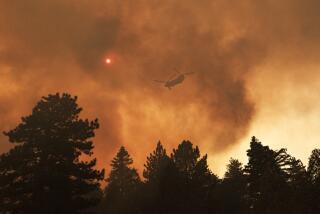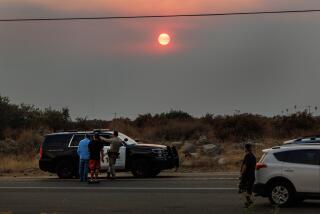Smoke from wine country fires leads to 200 canceled flights, hazardous air quality: ‘It is basically like living in Beijing’

The deadly fires raging in Northern California have devastated thousands of acres of bucolic wine country and torched thousands of homes, but the damage isn’t limited to the scorched rolling hills north of the San Francisco Bay.
Health officials say the Bay Area is experiencing the worst air quality ever recorded in many parts of the region, particularly near the fires.
The wood smoke — filled with fine particulates from the fires — has spread through the entire region, casting an uneasy and unhealthy haze over the bay.
The choking smoke has gotten so thick that 206 flights coming in and out of San Francisco International Airport were canceled on Tuesday and Wednesday because of low visibility due to smoke — about one in 10 flights were canceled on Tuesday alone.
The National Weather Service said it was receiving reports of ash falling from the sky around the Bay Area.
“It is basically like living in Beijing,” said John Balmes, a professor of medicine at UC San Francisco and of Environmental Health Sciences at UC Berkeley’s School of Public Health. During a telephone interview, Balmes said students were even wearing masks on the East Bay campus.
In reality, Beijing had better air quality than some parts of the Bay Area on Thursday.
For most of Thursday, Bay Area cities occupied every spot on the Environmental Protection Agency’s list of the top five cities with the nation’s worst air quality, with Napa leading the way.
“We have never had a fire like this impact so many people for such a long period of time,” said Bay Area Air Quality Management District spokesman Tom Flannigan. “And we have never had smoke impact the entire Bay Area like this.”
Over the last few days, cities near the fire zone have seen the worst levels on the air quality index — which measures the kind of fine particulate pollution that can enter the body through the lungs on an index from 0 to 500.
Parts of Napa County were above 200 on Thursday — a level considered very unhealthy — according to monitoring stations maintained by the Bay Area Air Quality Management District. Earlier in the week, some recording stations close to the fires had recordings in the 400s — hazardous levels.
San Francisco on Thursday was sitting at 161 — about 4 to 5 times EPA standards for clean air, Balmes said.
It is a far cry from the normally clean air the region usually experiences thanks to a constant sea breeze that serves as a natural air conditioner. In 2016, Napa and Sonoma County both averaged an air quality index level of 32 while San Francisco landed at 36.
Sean Raffuse, an air quality analyst at the UC Davis Crocker Nuclear Laboratory, said the smoke from the massive fires has produced as much fine particulate pollution in two days as all the state’s cars do in a year.
Health officials at the district put in an emergency order for 20,000 respirator masks and have begun to distribute them at fire evacuation centers in the north Bay Area, where the air quality is the worst, Flannigan said.
The air quality district is recommending that residents in counties where fires are burning take refuge in buildings with filtered air, such as public libraries and shopping malls — or leave the area entirely.
In the rest of the Bay Area, officials are advising those who can smell smoke to close their windows and set their air conditioning units to recirculate inside air.
Children, the elderly and those with respiratory conditions such as asthma, emphysema and heart disease are most affected. Balmes said even healthy people should avoid heavy exertion outside. He said the long-term health effects should be minimal for those not near actual flames and smoke sources.
Those closest to the flames could suffer smoke inhalation and face an increased risk of asthma.
One reason for the unprecedented situation is that offshore winds are blowing from the northern parts of the Bay Area, pushing the smoke south into cities, said Charles Bell, a meteorologist with the National Weather Service.
On top of that, an inversion layer is set up around the Bay Area, meaning a layer of hot air has trapped the smoke from rising into the upper atmosphere where it could drift away, said Richard A. Minnich, a professor of earth sciences at UC Riverside.
“It just stays along the ground, so the smoke is terrible,” he said.
The Bay Area is stuck with these conditions at least through the weekend.
“What we really need is a sea breeze to come back in,” he said.
More to Read
Sign up for Essential California
The most important California stories and recommendations in your inbox every morning.
You may occasionally receive promotional content from the Los Angeles Times.











